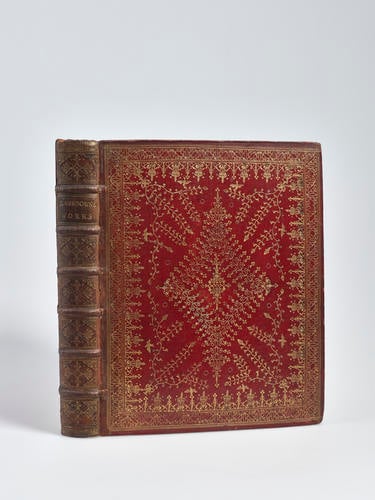The Genuine works in verse and prose of the Right Honourable George Granville, Lord Lansdowne / by George Granville. 1732
29 x 23.5 x 4.5 cm (book measurement (conservation)) | RCIN 1087006

George Granville, 1st Baron Lansdowne (1667-1735)
The Genuine works in verse and prose of the Right Honourable George Granville, Lord Lansdowne / by George Granville 1732


-
George Granville, Baron Lansdowne, was a playwright, poet and Tory politician active in the late seventeenth and early eighteenth century. Distantly related to George Monck, the general who helped to restore Charles II to the throne in 1660, Granville was an ardent supporter of the Stuart dynasty. Following the ‘Glorious’ Revolution of 1688, he supported James II and may have visited the king at his home St Germain while on a visit to Paris in 1690. He spent much of the next decade writing plays and poems that complimented the virtues of the exiled Stuarts.
Granville’s early plays utilised themes taken from John Dryden’s translations of the writings of Homer. He also made adaptations of some of the plays of Shakespeare for a contemporary audience. These initial endeavours were not hugely successful, but the production of a musical play, The British Enchanters, based on a play he had written in 1691, proved wildly popular. Granville revised the work in 1707 and added a final scene glorifying the achievements of Queen Anne.
It was during the reign of Queen Anne that Granville became a prominent Tory politician. From 1707, he was the leader of an important faction in Parliament representing the interests of Cornwall (the county having 41 seats in the House of Commons) and in 1710, became secretary of war. However, on the accession of George I in 1714, the Tory government was dismissed in favour of Whigs who had supported the Hanoverian succession. As a result, Granville went into retirement at Longleat, the Wiltshire home of his stepson, Viscount Weymouth. During this time, he offered support to the ‘Old Pretender’, James Francis Stuart’s claim to the throne and in September 1715, was arrested for treason and imprisoned in the Tower.
Following a brief period in France, in 1725, Granville sought to reconcile with the new Hanoverian dynasty. In 1732, he published this edition of his Works, dedicated to Queen Caroline, the consort of George II. The Queen was a notable patron of the arts and this work, although containing eulogies in praise of James II and Mary of Modena, was among books by contemporary British writers listed in her library catalogue.
It is unknown if this was Queen Caroline’s copy of the book, but the elaborate binding suggests it may have been made for presentation. It was certainly owned by George III, and a copy of the work is listed in the catalogue of his library at Richmond Lodge in 1766. That library was moved to Kew Palace in 1773 and books were then transported from there to George’s other residences. The present volume was listed in the 1780 catalogue for the king’s library at Windsor and bears George’s bookplate.
It was one of the books selected by Olwen Hedley in the 1960s as a fine example of bookbinding in the Royal Library at Windsor Castle. Hedley’s ‘Additional Bookbindings’ serve as a supplement to the catalogue of fine bindings compiled in 1893 by the Royal Librarian Richard Rivington Holmes.
Binding information
Contemporary red goatskin binding, with elaborate gold-tooling on both sides and spine.
On both sides, an outer border formed of two sets of triple fillet lines, filled with a series of oval and swirl tools as if a roll; followed immediately on the inside by another imitation roll border of separate swirling vine tools, surmounted by a series of crowns, interspersed with flower-heads, pointilles, and flying birds; in each corner, a small urn with handles, from which sprout a series of swirling vines surmounted by acorns; in the centre, a large diamond motif built up from several swirling vine and slower-head tools, with flower-head finials on each corner.
Sides and insides of both boards gold-tooled with flower-head and vine rolls.
Spine divided into seven compartments by raised bands, each tooled with a flower-head and vine roll. Second compartment tooled with double fillet border and the title: ‘LANSDOWNE / WORKS’; all other compartments tooled with double fillet border, flower and vine corner tools and a central design formed of star, acorn and crown tools. Head and tail of spine tooled with flower-head and vine roll.
Contemporary marble endpapers; all edges gilt.
Provenance
Probably the copy listed in the inventory of George III’s library at Richmond Lodge, prior to its dispersal c. 1766. In the library of George III at Windsor by 1780.
-
Creator(s)
-
Measurements
29 x 23.5 x 4.5 cm (book measurement (conservation))
32.0 x 6.0 cm (whole object)
Category







